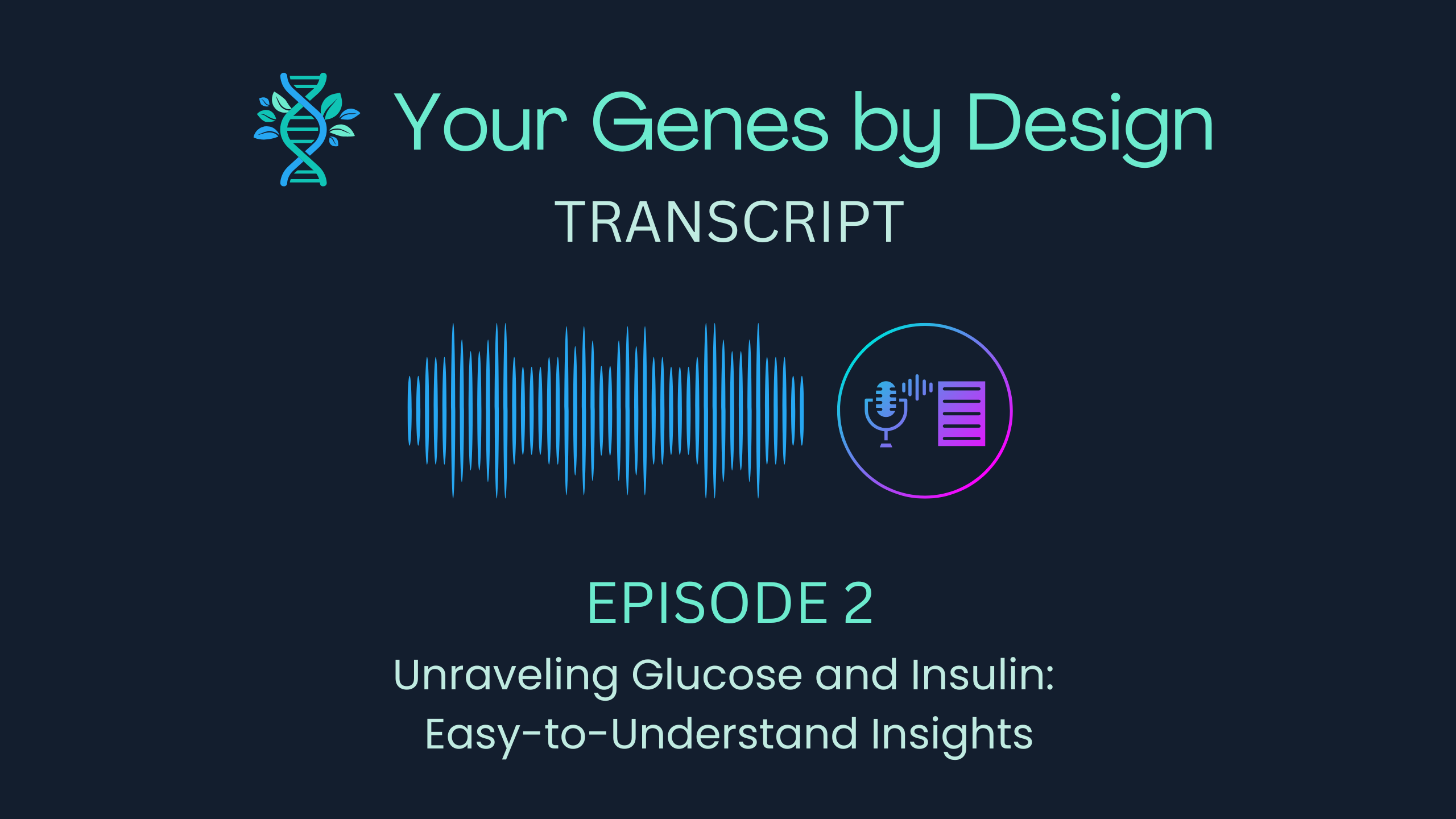
00:31 — Introduction
Hi, welcome back to Your Genes by Design. I’m Lauri Wakefield, and today we’re going to break down two words that come up frequently in health conversations, glucose and insulin.
They might sound scientific, but they’re easy to break down. And once you understand how they work together, it changes how you think about energy, cravings, and even mood.
For years, I heard people talk about blood sugar, but I didn’t really pay much attention to it. I figured it only mattered if you had diabetes or were borderline diabetic.
But what I didn’t realize was how much glucose and insulin affect almost everything that happens in your body throughout the day.
I don’t know about you, but I’ve been there — the mid-afternoon crash, the craving for something sweet that seems to come out of nowhere, and that foggy feeling when you’re hungry but not sure what your body actually needs.
Those moments often trace back to how your body is handling glucose and how responsive it is to insulin.
01:00 — The Everyday Connection
Let’s break it down with a simple explanation. Glucose is your body’s main source of fuel. Every time you eat carbohydrates — whether it’s fruit, vegetables, oatmeal, or bread — your body breaks them down into glucose, which then enters your bloodstream.
But not all carbohydrates behave the same way. Whole foods like fruits, vegetables, and oats contain fiber, water, and nutrients that slow digestion.
So glucose enters your bloodstream more gradually. But refined foods like white bread or pasta break down much faster, leading to a sharper glucose spike.
When that happens, your body releases insulin, a hormone made by your pancreas that moves glucose from your blood into your cells, where it can actually be used for energy.
01:40 — The Simple Breakdown
Think of insulin as the key that unlocks the door. When things are working well, you eat, glucose rises a little bit, insulin opens the door, your cells take in what they need, and your energy stays steady.
But if your cells become less responsive to insulin — which is known as insulin resistance — that door doesn’t open as easily.
Your body senses that glucose is still in the blood, so it releases even more insulin to try to move it where it belongs.
Over time, producing too much insulin can lead to crashes, cravings, and eventually bigger health issues like prediabetes, type 2 diabetes, and heart disease.
02:40 — The Genetics Layer
Here’s where genetics can add another layer. Some people naturally handle carbohydrates more efficiently than others.
For example, if you carry certain TCF7L2 gene variants, your body might release more insulin after eating, which can make you more sensitive to refined carbs or sugary foods. Over time, that can influence how easily your blood sugar stays balanced.
Other genes like FADS1 and PPARGC1A affect how your body turns fats into energy.
FADS1 helps convert plant-based omega-3s into the active forms your body actually uses, which support healthy insulin sensitivity.
PPARGC1A is involved in mitochondrial function — it helps your cells turn fuel into energy efficiently.
When that process works well, your metabolism feels more stable and your recovery improves.
That’s part of the reason why two people can eat the same meal — one feels satisfied and balanced afterward, while the other ends up tired, sluggish, or craving something more.
It’s not just about willpower or diet choices. Your biology is part of the picture.
03:10 — A Real-Life Example
You start the day with a bagel — quick carbs, not much protein or fiber.
Your glucose spikes, insulin jumps in to help, and a few hours later, you hit that crash and start reaching for something else. Does that sound familiar? You might feel drained or craving something sweet.
It’s a combination of what you put in your body and how your system processes it — both play a role.
Now imagine you have that same bagel, but with some scrambled eggs and a few almonds. The protein and fat slow digestion, your glucose rises more gradually, insulin doesn’t have to work as hard, and your energy stays more stable.
These small tweaks are what help your body stay responsive — not perfect, but balanced.
If you’ve ever felt tired, cranky, or foggy a few hours after eating, that’s your glucose–insulin system sending a message.
04:50 — The Real Goal
It’s not just about cutting carbs or avoiding sugar.
It’s about learning what keeps your body in balance — because the more responsive your cells are to insulin, the smoother your energy, mood, and metabolism will be.
And that responsiveness is something you can strengthen over time — through food choices, movement, quality sleep, and managing stress.
Your genes might set the starting point, but your daily habits shape how those genes are expressed.
Here’s the precision piece: if you’ve ever felt like you’re doing everything right — eating well, moving your body, getting enough sleep — but still notice energy dips or cravings that don’t make sense, your genes might be the missing key.
Certain genetic variants and your specific genotype can influence how your body handles carbs, fats, and energy.
Your genes set the job: TCF7L2 helps regulate insulin release. FADS1 helps convert plant-based omega-3s into EPA and DHA. PPARGC1A supports mitochondrial energy production.
A variant is a small change in the DNA code within that gene, and your genotype shows which versions you carry.
That combination can shift how efficiently your body performs those functions.
For example, some genotypes in TCF7L2 are linked to higher insulin release after meals, which can make you more sensitive to refined carbs or glucose swings.
Others in FADS1 may lower your conversion of omega-3s, while certain PPARGC1A types may impact energy stability or exercise recovery.
06:00 — Working With Your Design
Knowing your genotype brings precision — it helps you understand what your body actually needs.
Maybe that means adjusting how you pair carbs and protein, emphasizing omega-3s, or supporting your mitochondria for steadier energy.
It’s not about restriction or chasing perfection.
It’s about understanding your design so that you can make choices that truly work with your body, not against it.
If this has helped you see glucose and insulin in a clearer way, follow Your Genes by Design for more bite-sized episodes that connect your biology to everyday life — especially after the age of 45.
Because understanding your genes isn’t about predicting problems.
It’s about using insights to work with your body, not against it.
